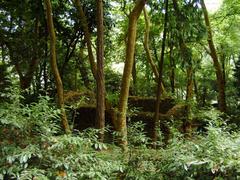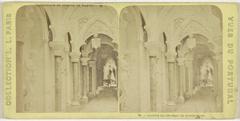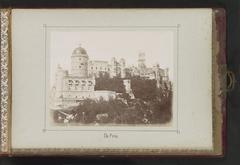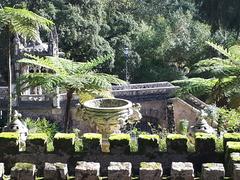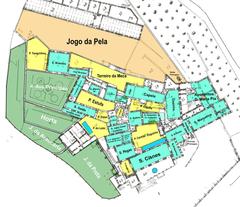
Queluz-Belas Train Station: Visiting Hours, Tickets, and Historical Significance in Sintra
Date: 04/07/2025
Introduction
Queluz-Belas Train Station is a pivotal transportation hub in the Sintra municipality, bridging Lisbon’s urban pulse with Sintra’s historic and natural wonders. Since the late 19th century, the station has evolved from a simple railway stop into a culturally significant gateway, providing seamless access to major attractions such as the adjacent Queluz National Palace, famed for its Rococo architecture and royal heritage. The station itself stands as a testament to Portugal’s railway history, blending traditional azulejo tilework with modern upgrades like electrification and enhanced accessibility, ensuring it meets contemporary travel needs (Sintra Portugal Tourism).
Operated by Comboios de Portugal (CP), the station offers frequent suburban train services connecting Queluz-Belas with Lisbon’s Rossio and Oriente stations, as well as central Sintra. This reliable network makes the station indispensable for daily commuters and visitors exploring Sintra’s palaces, gardens, and castles (Sintra Explorers).
Beyond its role in transportation, Queluz-Belas Train Station has contributed to the suburban growth of Queluz and Belas, supporting community development while maintaining its historical character through careful conservation. Facilities include step-free access, real-time information systems, and convenient ticketing options such as the Viva Viagem card, which enables integrated travel across Lisbon’s public transit.
A short 15-minute walk or brief bus ride from the station brings visitors to the stunning Queluz National Palace, where immersive guided tours and well-maintained gardens await. This comprehensive guide explores the station’s history, amenities, and practical travel information, while also offering detailed insights for visiting Queluz National Palace. For the latest updates, consult the official CP website or travel apps like Audiala (CP Official Website).
Table of Contents
- Introduction
- Historical Development of Queluz-Belas Train Station
- Modernization and Infrastructure Upgrades
- Cultural and Historical Significance
- Visitor Experience and Practical Information
- Frequently Asked Questions (FAQs)
- Queluz National Palace: History, Visiting Information, and Transport
- Queluz National Palace: Access Guide and Summary Table
- Final Tips and References
Historical Development of Queluz-Belas Train Station
Origins and Early Years
Queluz-Belas Train Station opened in the late 19th century as part of the Sintra Line (Linha de Sintra), an important expansion during Portugal’s industrial era. The station was closely tied to the development of nearby Queluz National Palace, a royal residence that became more accessible to both nobility and the public with the arrival of the railway (Sintra Portugal Tourism).
Architectural Features and Heritage
The station’s original design embodied the practical yet elegant style of the period, featuring Portuguese azulejos—iconic blue-and-white tiles that adorn the façades and waiting areas. These decorative elements survive in part today, offering a glimpse into the station’s heritage. Over time, careful restoration has ensured the preservation of these details, blending them with necessary modern upgrades (Sintra Portugal Tourism).
Modernization and Infrastructure Upgrades
Electrification and Service Improvements
Significant modernization in recent decades saw the electrification of the Sintra Line, improving efficiency, increasing frequency, and reducing environmental impact by eliminating diesel locomotives. Modern CP suburban trains now offer regular, reliable service between Lisbon, Queluz-Belas, and Sintra (Sintra Explorers).
Accessibility and Passenger Facilities
Upgrades include elevators, ramps, tactile paving, and accessible restrooms, making the station fully navigable for those with reduced mobility. Electronic ticket machines, real-time departure boards, and improved lighting enhance passenger convenience and safety. The station’s waiting areas have been refurbished while preserving original tilework (Sintra Portugal Tourism).
Integration with Regional Transport Networks
Queluz-Belas is a connecting hub for trains and local buses, facilitating onward journeys to Queluz National Palace, Sintra, and Lisbon’s suburbs. Combined train-and-bus tickets are available, and bus stops are conveniently located outside the station (Sintra Explorers).
Cultural and Historical Significance
Gateway to Queluz National Palace
Queluz-Belas Train Station is the primary rail gateway for visitors to the Queluz National Palace—a “Portuguese Versailles” boasting lavish rooms, ornate gardens, and centuries of royal history. The palace’s accessibility via the railway helped shape its role as a cornerstone of cultural tourism (Sintra Portugal Tourism).
Role in Suburban Development
The railway’s arrival spurred the transformation of Queluz and Belas from rural villages to thriving suburbs, encouraging residential growth and commerce. Today, the station serves both commuters and cultural tourists, reflecting the area’s dual character.
Preservation of Railway Heritage
Efforts to maintain original features, particularly the azulejos, ensure Queluz-Belas remains a living monument to Portugal’s railway past.
Visitor Experience and Practical Information
Visiting Hours
- Station Operations: Daily from 5:00 AM to 1:00 AM
- Ticket Offices: 6:00 AM to 11:00 PM
- Ticket Machines: 24/7
Tickets and Pricing
- Lisbon to Queluz-Belas: €1.50–€2.00 (one-way)
- Queluz-Belas to Sintra: €1.40–€1.80 (one-way)
- Discounts: Available for seniors, children, youth, groups, and with Viva Viagem or Lisboa Card.
- Purchase: At staffed counters, electronic machines, or online
Navigating the Station
Clear bilingual signage, elevators, ramps, and tactile paving make navigation straightforward. Real-time display boards and local bus/taxi options are available outside.
Tips for Tourists
- Train Frequency: Every 15 minutes (weekdays); 30 minutes (weekends/holidays)
- Journey Time: 20–25 minutes from Lisbon Rossio
- Peak Hours: Early mornings, late afternoons, weekends, and holidays
- Amenities: Cafés, shops, ATMs, and accessible restrooms nearby
Connection to Sintra and Beyond
Queluz-Belas is a stop en route to Sintra, where connecting buses take visitors to renowned sites like Pena Palace and Castle of the Moors (Sintra Explorers).
Frequently Asked Questions (FAQs)
Q: What are the opening hours for Queluz-Belas Train Station?
A: Daily from 5:00 AM to 1:00 AM; ticket offices from 6:00 AM to 11:00 PM.
Q: How do I buy tickets?
A: At staffed counters, ticket machines, or online. Viva Viagem cards are recommended.
Q: Is the station accessible?
A: Yes, it offers ramps, elevators, accessible restrooms, and tactile paving.
Q: How far is Queluz National Palace?
A: A 15-minute walk or short bus/taxi ride.
Q: Are combined train and bus tickets available?
A: Yes, for seamless regional travel.
Queluz National Palace: History, Visiting Information, and Transport
History and Cultural Significance
Queluz National Palace, built in the mid-1700s, was a summer residence for the royal family and is celebrated for its Rococo, Baroque, and Neoclassical architecture. The palace includes lavish gardens, ornate fountains, and notable rooms like the Music Room and Throne Room (Parques de Sintra).
Visiting Hours and Ticket Prices
- April–September: Tues–Sun, 9:30 AM–6:30 PM (last entry 5:30 PM)
- October–March: Tues–Sun, 9:30 AM–5:30 PM (last entry 4:30 PM)
- Closed: Mondays, Jan 1, May 1, Dec 25
Tickets:
- General admission: €5.00
- Reduced: €2.50 (EU residents 18–25)
- Free: Children <18, seniors >65, EU teachers, first Sundays of the month
- Purchase online or at entrance
Guided Tours and Events
Guided tours (additional fee) offer deeper insights into the palace’s history. The palace hosts events, concerts, and temporary exhibitions—check the official website for schedules.
Access and Transport Options
Train
- Nearest Station: Queluz-Belas (1.1 km, 15-min walk)
- From Lisbon Rossio: 18 min
- From Oriente: 33–45 min
- Train Frequency: Every 10–15 min (weekdays), 30 min (weekends)
(LisbonLisboaPortugal.com)
Bus and Taxi
- Local Bus 25: Connects station to palace (less frequent)
- Taxi: €3–4 from station
- Vimeca Bus 101: From Lisbon’s Colégio Militar (less recommended for most visitors)
Walking Route
From Queluz-Belas Station, follow Avenida António Enes and Avenida da República—well signposted and safe (manymoremaps.com).
Car and Parking
Access from A27 expressway; large car park opposite the palace. Do not leave valuables in vehicles (lisbonlisboaportugal.com).
Additional Visitor Tips
- Best Time to Visit: Early morning or late afternoon for fewer crowds and better light.
- Visit Duration: 2–3 hours recommended for palace and gardens.
- Amenities: Limited tourist infrastructure in Queluz—bring refreshments.
- Accessibility: Both the station and palace are equipped for visitors with reduced mobility.
Queluz National Palace: Access Guide and Summary Table
| Feature | Details |
|---|---|
| Opening Hours | Apr–Sep: 9:30–18:30; Oct–Mar: 9:30–17:30; Closed Mon |
| Ticket Prices | €5 general, €2.50 reduced, free for children/seniors/groups |
| Train Station | Queluz-Belas (1.1 km, 15-min walk) |
| Train Frequency | Every 10–15 min (weekdays), every 30 min (weekends) |
| Bus Connections | Local Bus 25, Vimeca 101 |
| Taxi Fare | €3–4 from station |
| Parking | Car park opposite palace |
| Accessibility | Step-free, ramps, elevators, accessible restrooms |
Final Tips and References
Queluz-Belas Train Station and Queluz National Palace together offer a blend of heritage, convenience, and accessibility, making them ideal for both commuters and cultural explorers. Plan ahead using official resources and travel apps, and consider early or late visits for the best experience. Download the Audiala app for real-time travel updates, and check official websites for any changes to schedules or ticketing.
References
- Sintra Portugal Tourism
- Sintra Explorers
- Parques de Sintra
- LisbonLisboaPortugal
- ManyMoreMaps
- Portugal Visitor
- Visit Lisbon
- Wikipedia - Queluz-Belas Railway Station









